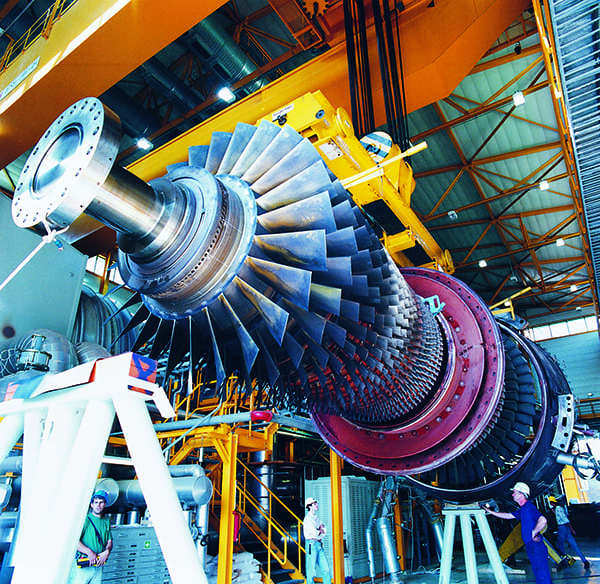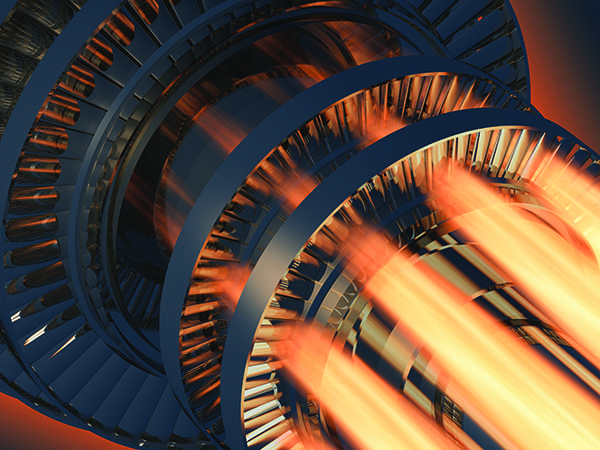Lubrication: Optimizing the Performance of Today's Gas Turbines
Modern gas turbines are designed to deliver more power and greater efficiencies. Several manufacturers, including GE, Siemens, and others, have established new marks for efficiency over the past year, reaching upward of 65%.
Achieving optimal performance from these machines requires a best-in-class maintenance approach. This new equipment operates at higher operating temperatures than before, which can in turn place greater stress on critical turbine components. If operators do not take the proper precautions, these conditions can lead to performance issues such as:
■ Reduced lubricant life.
■ Reduced turbine bearing life.
■ More frequent downtime intervals.
■ Increased waste oil streams.
Ultimately, these can all lead to lost productivity and reduced profit per kilowatt-hour. So how should operators build the best maintenance strategy? It starts with lubrication, which is the first line of defense to protect equipment from harsh operating conditions. Operators need to develop a lubrication program tailored to meet the performance demands of modern power generation equipment.
All lubrication programs should be built around two fundamental elements: choosing the right lubricant, then monitoring the real-time performance of that equipment through a service such as used-oil analysis (UOA).
Choosing the Right Lubricant
Many lubricant suppliers offer products specifically formulated to perform in gas turbine applications (Figure 1). These products are formulated to provide superb wear protection across a wider range of operating temperatures compared to conventional turbine oils, helping reduce sludge and varnish formation, keeping parts clean and running smoothly, and reducing filter plugging. These features can help maintain or enhance equipment reliability and lower used oil disposal costs through extended oil life.
Once you’ve selected the right oil, there are at least six steps you can take to ensure the oil performs as expected.
Keep Oil Clean. Maintaining turbine oil cleanliness is important for optimizing equipment and lubricant life. Particulate contamination, the most destructive element in lubricating oil, will significantly reduce the life of bearings and gears while also impacting servo-valve operation and causing system foaming. Turbine systems are subject to contamination from several sources and deposits will accumulate even though the oil is clean. Operators should inspect the system frequently and maintain the filtration system to its maximum effectiveness. In general, turbine bearing oils should be maintained at an ISO Cleanliness Level (or ISO Particle Count) of 18/16/13 or lower and hydraulic systems should be maintained at an ISO PC code of 16/14/11. However, operators should consult with their original equipment manufacturer to identify the recommended cleanliness level for each application.
Keep Oil Dry. Water is the second most-destructive contaminant in lubricating oil. Exposure to excess water can reduce turbine bearing life and longevity. Water contamination not only displaces the oil film—in cases of extreme contamination—but also causes sub-surface micro-cracking due to hydrogen “free radicals,” which break off from water molecules as they pass between the rollers and raceways. This micro-cracking, also called “hydrogen embrittlement,” progresses over time to pitting and spalling. The most common method of continuous water removal is centrifugal purification for large amounts of water. Alternatively, vacuum dehydration (polishing) or coalescing filters can be used for concentrations under 400 ppm. In general, turbine lube oil systems should be kept below 200 ppm water.
Ventilate. As mentioned previously, oil and water don’t mix. Adequately ventilating your turbine lubrication system will help remove water and minimize its harmful effects. When vacuum venting is used, negative pressure over the oil in the system should be accurately controlled. In atmospheric pressurized systems, be sure the air vent is sufficiently sized and has a good moisture/air breather in place.
Prevent Leakage. Leaking oil is not only wasteful and detrimental to productivity, it is a safety hazard, and leaks should be traced to their source and eliminated. Leakage is often caused by contamination in bearing seals, oil-supply lines, cooler tube joints, and valve connections. Excessive oil-supply pressure can also lead to leakage. Finally, you can eliminate water leakage into oiling systems from turbine seals, oil coolers, and other sources through continuous purification and ventilation. You’ll want to keep these prevention practices in operation for as long as necessary.
Maintain Temperature Records. Keep a temperature log of:
■ Oil and water to and from coolers.
■ Oil in reservoirs.
■ Oil return from main bearings.
■ Oil inlet to purification equipment.
This will help operators notice any sudden changes, so performance issues can be identified and investigated sooner. Gradual changes in oil coolers may indicate the formation of deposits on cooling surfaces. Maintaining sufficiently high temperatures in reservoirs and purification equipment will aid in removal of water and insoluble contaminants.
Keep Operating Records. Keeping meticulous records is essential to managing a good lubrication and maintenance program. Maintenance teams should keep records of:
■ Turbine and purification operating hours.
■ Oil condition, lab results, and service hours.
■ Time and amount of make-up and whether new or purified oil was used.
■ Time of filter change and service hours.
■ Repairs, replacements, and overhauls.
Keep Tabs on Oil Performance
While the steps outlined here will help you maintain the performance of your oil, conducting regular UOA is critical to ensuring that oil is operating at peak performance. Oil analysis provides operators with critical insights that can help them detect the onset of deterioration, contamination, and other troubles. This enables corrective action to prevent unexpected and costly downtime.
Specifically, UOA can help provide operators with important information related to three key areas: equipment condition, lubricant condition, and contamination.
Equipment Condition. Oil analysis can provide detailed information about metal wear and help operators understand the metallurgy of the components being tested. Preventing excessive metal wear can help avoid equipment failure or operational challenges.
Lubricant Condition. Maintaining the physical properties of the lubricant is important to extending the equipment’s reliability and the life of the lubricant. UOA results help indicate the condition of a lubricant by providing insight into oxidation and viscosity, among other characteristics. The products of lubricant degradation, including sludge and varnish (Figure 2), are usually unstable in the oil and will form deposits or separate from the bulk oil.
Contamination. Contamination is a primary cause of component wear or failure, and UOA is one of the most valuable tools in helping identify contamination. A number of sources can contribute to contamination, including built-in contamination from the component manufacturing or installation process; self-generated contamination from system components worn or damaged by other particles; and external ingression. By identifying the existence of contaminants via UOA, operators can then identify the cause and take action before it results in unscheduled equipment downtime.
Best-in-Class Program in Action
When operators build a lubrication program that integrates these best practices, the results can be impactful.
Consider the experience of Monmouth Energy, a New Jersey-based power producer. The company operates two Solar Turbines Taurus 60 gas turbines that convert landfill gas into power at a site in Tinton Falls. Due to the challenging operating conditions associated with landfill gas, the company was seeking a lubricant solution capable of optimizing the performance of the turbines.
ExxonMobil recommended the company use a high-performance synthetic turbine oil formulated to deliver long-lasting component protection for extreme industrial gas turbine applications, including resistance to degradation at high temperatures and protection against rust and corrosion. It was also recommended the company implement routine UOA to monitor oil condition.
After putting the oil into service, the turbines exceeded 90,000 hours of operation on a single oil fill. Most importantly, UOA results confirmed that the oil delivered this long life without sacrificing any performance capability. By extending oil life and oil drain intervals, the company was able to improve productivity and power generation potential.
Lubrication is typically not thought of as a key business driver, but it’s a low-hanging opportunity to help optimize the performance of newer, more advanced equipment. A robust lubrication strategy—complete with high-quality lubricants and the use of the right services—can help operators protect equipment from the demanding operating conditions of a modern power generation operation, ultimately enhancing productivity and improving the bottom line. ■
—Gary Brown is a field engineer and Jim Hannon is a product technical advisor at ExxonMobil.

